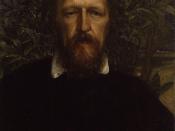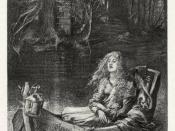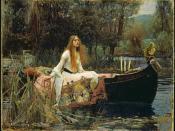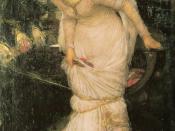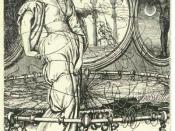These two poems, "The Lady of Shalott"ÃÂ and "Mariana in the Moated Grange"ÃÂ explore the ways in which Tennyson and Shakespeare represent their attitude toward the gender issues of their Time. Many romanticists and writers of the Victorian era were had a passionate love affair with nature, the countryside, and the creations of God. In this representation of women there is an interesting parallel to the genre of the maternal wife and the femme fatale.
In "Mariana"ÃÂ, the dejected heroine waits for a cut-off from the world, both physically and spiritually for her lover to come to her. Each stanza concludes with her repeated recital of her loyalty to her loved one, claiming that "My life is dreary.... I would that I were dead!'"ÃÂ (9-12). Here, the character is speculating upon how life would be worthless should she not be with her lover. Her loyalties of her man are such, that she would willingly give her life, and commit a great sin to be reunited with her love in heaven.
In the poem "Mariana in the Moated Grange"ÃÂ, the moat around the house strongly reinforces spiritual confinement. The imagery in the poem is dark and foreboding, which strongly reinforces Mariana's misery. Flowers and animals are described as dull and lifeless, which to me suggest that Mariana is detached from her surroundings. She cares not for superficiality, because love is (supposedly) deep and profound. "With blackest moss and flower-pots... All silver green and gnarled bark.... Either at morn or eventide"ÃÂ (1-16). Despite all of these rich images of natural beauty, they are marred with a dark dispose; such is her woe of segregation form the man whom she is devoutly loyal to.
El-Darazi, 2 In Tennyson's poem "The Lady of Shallot"ÃÂ, we gain an insight to a similar situation as the one in "Mariana"ÃÂ. This time, however, there are differing themes present. For instance, little light is shed upon the past of the Lady, and unlike Mariana, we have little background to draw ideas from. The first is a curse, a communication, a work of magic. This suggests that the world of "The Lady of Shalott"ÃÂ in which we are entering is one of fantasy and sorcery. The tapestry that the Lady weaves depicts her prior life, which she has surrendered for love, and decorated with scenes of the world she has determined to join. The single leaf that has fallen into her lap poignantly tells her story: her life is over; she is the "fallen leaf"ÃÂ. For love of Lancelot, she has renounced her life; she is a willing victim for love and a fallen woman.
The Lady's view of the world is restricted to reflections of the outside world she sees in the mirror. The lady sees the exterior world only as the shadow of the reality reflected in the magic mirror. Her curse does not allow her to appear where the exterior and interior worlds can meet and merge; she is totally cut off.
The male writers of the Victorian era such as Shakespeare and Tennyson were fascinated by their idea of the "ÃÂideal woman', an attractive and attentive person, who was solely devoted to fertility, procreation and the upbringing of a family. The emphasis upon love and confinement of the woman becomes intensified in the fictional Lady of Shalott. On the other hand with "Mariana and the Moated Grange"ÃÂ, she looks for confinement with her love and wants to be cut-off from the world.
